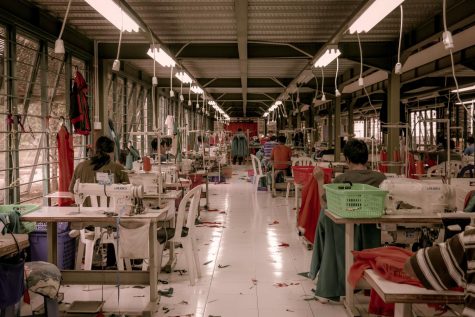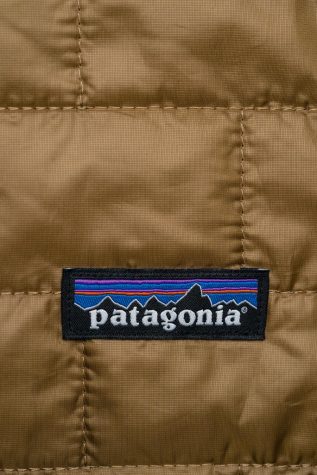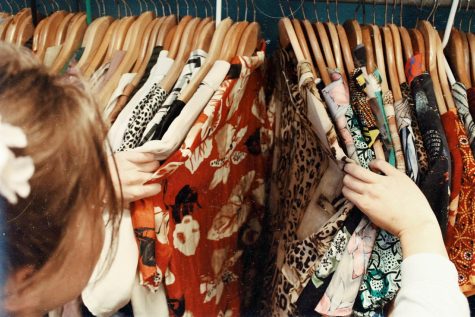The fashion industry is destroying Earth—here’s what you can do to help
In an age dominated by social media and influencers persuading individuals to keep up with ongoing fashion trends, it can be hard to not give into the pressure of fast fashion. Young adults are the greatest victims of this, with 48% of adults ages 18 to 29 purchasing clothing “because it’s trending,” according to a study by the Morning Consult. While keeping pace with trends may make consumers feel and look good, this doesn’t mean it is the most sustainable option.
The vast majority of “trendy” clothes stem from the fast fashion industry. Fast fashion mass-produces replications of trending designs at breakneck speeds for extremely low costs. Companies achieve these low costs by using cheap materials, producing products in crummy factory conditions and exploiting their workers in the process.
To spot a fast fashion brand look for extremely short catwalk-to-store turnaround; limited quantities to encourage fast-decision purchases; cheap, low-quality materials and offshore manufacturing. A few big-name brands that participate in fast fashion include H&M, Zara, Forever 21, Fashion Nova and Zaful.

The fashion industry produces 20% of global wastewater, according to the United Nations Economic Commission for Europe. This puts the fashion industry as the second largest polluter of clean water after agriculture.
The use of cheap, toxic textile dyes and synthetic fabrics are the leading causes for this. Synthetic fabrics like polyester, nylon, spandex and acrylic shed microfibers during washing that add to the increasing levels of microplastics in our waterways. A 2017 report from the International Union for Conservation of Nature (IUCN) estimated 35% of all microplastics in the ocean come from the laundering of synthetic textiles like polyester.
The World Bank reported that the fashion industry is responsible for 10% of humanity’s carbon emissions, which is more than all maritime shipping and international flights combined. The emissions are contributed to by the poor manufacturing processes, use of synthetic fabrics in production and the life cycles of articles of clothing.
If no action is taken, emissions from just textile manufacturing are projected to skyrocket by 60%, according to the United Nations Framework Convention on Climate Change. This would have a severely negative effect on not only the environment, but the atmosphere as the climate crisis continues to worsen by the year.
Fast fashion encourages “throw-away” culture because of the short lifespan of cheap materials and the speed at which trends change. Less than 1% of used clothing is recycled into new garments. The equivalent of one garbage truck of textiles is either dumped in a landfill or burned every second, according to a report from the Ellen MacArthur Foundation.
This equates to an estimated value of USD 500 billion lost every year due to gently used clothing rarely being recycled. In total, up to 87% of textiles enter landfills every year. The constant speed and demand of the fashion industry means there is also increasing stress on other environmental concerns such as soil quality, land clearing and biodiversity.

Fashion companies like Patagonia, Reformation and Miakoda are helping pave the way for consumers who prefer new clothing but want to shop sustainable. These “slow fashion” companies prioritize sustainable materials such as organic cotton, “deadstock” fabrics and recycled and/or regenerated synthetic fabrics.
These companies encourage consumers to invest in their clothing but come with high price-tags to compensate for the costs of the high-quality materials and good labor conditions. One article of clothing can cost anywhere from $30 to $1000 depending on the company.
This isn’t always feasible on a student budget. However, there are cheaper, more sustainable options for students: thrifting, upcycling, sewing and renting.
Thrifting
”Thrifting is really helpful to curate your own unique fashion sense.” said Fiona Costello, a UNCW senior who has been thrifting and upcycling her own clothes for years.
Thrifting involves shopping for gently used items at discounted prices. These items have been loved by previous owners but are typically in good enough condition to be useful to a new owner. Thrift stores around Wilmington include the Bargain Box of Wilmington, Goodwill and Vintage Values.

Although thrifting is a great and sustainable option, try not to buy in bulk because there are still people who use these stores as a way to get clothes they can afford.
”When you’re buying clothes in a [name brand] store, you’re already seeing pictures of people wearing it, so subconsciously you may want to look like them,” said Costello. “But when you see an article of clothing in the [thrift] store, you don’t know what it is going to look like yet. You don’t know if it was something trendy, but it just feels like you.”
Online thrifting provides a unique experience for consumers compared to thrifting in-stores. Platforms like Depop and Poshmark allow users to follow their favorite sellers which provides a curated experience. With the option to filter items, shoppers can also sort their item searches by their sizes, price ranges and brands—something you don’t get in stores.
Upcycling and Sewing
Upcycling and sewing clothes is another great option for students looking to break trends with handcrafted pieces suited for their unique style. Upcycling involves transforming once-loved pieces into articles of clothing that will conform with new styles and can be achieved with pre-consumer waste, post-consumer waste, or a combination of the two.
“I recommend upcycling as much as possible, or if you don’t have the skill, find someone who does and don’t be afraid to pay for it. I would rather put $10 [to] $30 into one of my favorite articles of clothing instead of getting rid of it.” Costello said. As for sewing clothes, the initial costs can add up, but overtime the most expensive aspect is time. “Thread is inexpensive, fabric is inexpensive… but it’s really just time. You’ll end up spending a lot of time working on it.”
Renting
For students who still want to keep with trends, renting is a great option. Rental services allow consumers to browse through a vast selection of clothing, select the options that best match their personal styles and hold onto them for as long as they need. Rent the Runway and Nuuly are great examples of clothing rental services offering monthly subscriptions for as little as $69/month. Renting is not only a sustainable option but allows consumers to wear new clothes without the costly price tag, minimizes dry cleaning costs and extends the life of garments.
Ultimately, the most sustainable option is for individuals to wear what is currently in their closets. This, in combination with opting for sustainable alternatives when making clothing purchases, can help send a message to the fast fashion industry about the changing interests of consumers. After all, fast fashion can only end if the industry loses its income source: the customers.








